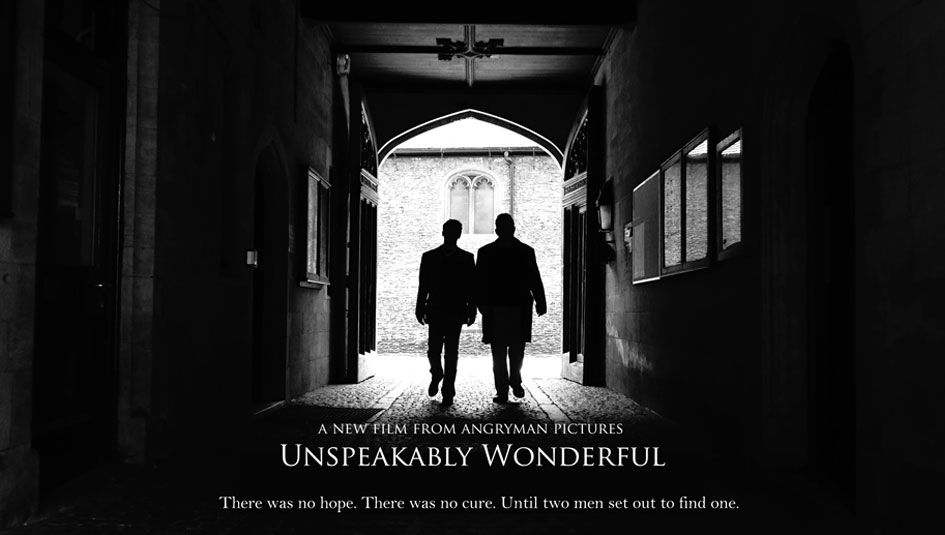Film Probes Banting’s “Complex Motivations” and Capacity to Abuse Animals

“There was no hope. There was no Cure. Until two men set out to find one.” This is the tagline for the UK film-in-progress Unspeakably Wonderful about the four scientists involved in the discovery of insulin. Neil Fleming and Matthew Lockyer (a screenwriter and a physician) collaborated to write the script, and they recently generated enough funding through crowdsourcing to hire a world-renowned script editor and cast a director. Next, they will approach other investors and secure a lead actor.
Unspeakably Wonderful will be directed by Alex Tweedle and produced by Angryman Pictures. Provided that production goes as anticipated, the film will reach an international audience. To expand the story’s appeal, the writers chose the form of drama, rather than documentary. The “drama” to be depicted on screen is, of course, the infighting between the infamous foursome: Frederick Banting, Charles Best, John Macleod, and James Collip. Banting and Macleod won the Nobel Prize for insulin’s discovery in 1923. But “behind their triumph lies a story of rivalry and ambition, of near-failure and wrecked lives.”
According to Fleming and Lockyer, Unspeakably Wonderful “aims to de-mythologise the ‘march of science’ (and the way scientific discoveries are often portrayed with 100% hindsight as the inevitable outcome of brilliance or altruism).” From their perspective, Banting was far more complicated and imperfect than history suggests. In fact, all four men had “a mixture of strengths and human frailties.” The film’s dramatic thrust comes from an examination of these mixtures and from the revelation that “Banting working alone would not have made the finish line.”
This film is not the first to reveal the behind-the-scenes feuds and “get to the bottom of things” with respect to each man’s role. This month, Slate released a documentary that also explored the “cultural myth” surrounding insulin’s discovery. As that film’s voiceover explains, insulin’s story is one “of two underdogs [Banting and Best] who came of nowhere and cured* one of the world’s most dreadful diseases.” Problematically, those filmmakers explicate, this underdog narrative obscures the integral role of Collip, the chemist who purified Banting’s serum when the physician was unable to do so himself.
The UK film’s title invokes insulin’s most famous patient, Elizabeth Hughes, daughter of then United States Secretary of State Charles Evans Hughes. While under Banting’s care, Hughes used the locution “unspeakably wonderful” to describe insulin therapy in a letter to her mother. Fleming and Lockyer told Insulin Nation that there was another real-life patient (Joe Gilchrist, one of Banting’s medical colleagues) in the early drafts, but the script editor cut this character to give more attention to the “central dysfunctional quartet.” They added that there is “a fictitious young diabetic from a poor background who helps explain Macleod’s motivation in ever allowing Banting to start his research.”
When asked if the film will draw attention to the inaccessibility of insulin (both in the early days and in the present), the writers indicated otherwise: “It is not a polemic for any viewpoint of diabetes as a disease, or the issues that have surrounded the production and availability of insulin subsequent to its discovery.” Unspeakably Wonderful’s purpose is to “entertain an international mass audience” by dramatizing the events that transpired between the four men.
However, the film will raise ethical concerns about the abuse of animals involved in the research. As Fleming and Lockyer explain, “The screenplay does not flinch from portraying the grim experimental work undertaken on dogs by Banting and Best, and sanctioned by Macleod. There is no doubt that the methods used would be unacceptable today, and indeed were distressing to the scientists involved at the time.”
The character explorations shed light on how the scientists were capable of such horrific abuse. Fred Banting, for instance, “was raised on a farm, and it’s clear that he cared about the dogs – but he went ahead anyway.” This may be because “Banting was scarred, literally and psychologically, by the Great War, hardened by it yet deeply affected by the way that war randomly snuffs out young lives.” He may have perceived the fight against diabetes as something like war. “Did he – along with Macleod – reason that the end justifies the means? Or was he driven by ambition, even vanity? Our story explores these and other questions about the complex motivations that underlay all four scientists’ participation in the research.”
For more information, including blog updates and biographies of those involved in the project, visit www.unspeakablywonderful.com.
*Editor’s Note: Contrary to the verbiage used, insulin is a treatment, not a cure.
Do you have an idea you would like to write about for Insulin Nation? Send your pitch to submissions@insulinnation.com.
Thanks for reading this Insulin Nation article. Want more Type 1 news? Subscribe here.
Have Type 2 diabetes or know someone who does? Try Type 2 Nation, our sister publication.